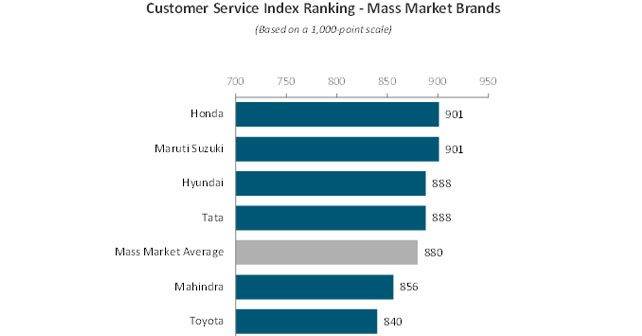
It’s no surprise to see Japanese car makers rank higher up in customer service surveys. Maruti Suzuki stays at the top while Honda ups its game.
In the 2016 J.D. Power Customer Service Index Study Honda and Maruti Suzuki tied for top spot with a score of 901 points on a thousand point scale. According to the study India’s leading car maker Maruti Suzuki performed well on all parameters while Honda closed the gap by improving on the grounds of service initiation and service quality to step up its game. Hyundai and Tata came in jointly at second with 888 points as both companies were regarded to have improved the most in the year ago period. What comes as a surprise is that Toyota ranked fourth with 840 points while Mahindra claimed the last podium spot with 856 points.
J.D. Power’s Customer Service Index study (now in its 20th year) is trusted to be one of the most reliable sources of vehicle ownership evaluation. Customer Service Index (CSI) is a survey that gets in touch with owners of new vehicles and records their response on the after-sales service process by examining dealership performance in five factors (listed in order of importance): service quality; vehicle pick-up; service advisor; service facility; and service initiation. The study examines service satisfaction in the mass market segment. Satisfaction is calculated on a 1,000-point scale. The study factored in vehicles purchased between May 2014 and August 2015 by analyzing responses from 7,843 owners.
For 2016, overall service satisfaction in the mass market segment improved by 14 points to 880 points on the 1,000 point scale. Overall satisfaction in the western part of the country is 900 points while the northern region is rated at 857 points. Strong differences in customer behavior, preferences and expectations have resulted in the substantial disparity in regional scores. One factor the study highlighted was that 82 per cent customers in the west schedule service appointments while only 55 per cent do it in the North. This gives dealerships in the west more lead time to manage workload in order to service cars in a better manner. Also people up north drive their cars 11 per cent more on an average in the first 12 to 24 months leading to more wear and tear, hence more complaints and problems.
“In an astoundingly diverse market like India where every region and state has its own unique characteristics and needs, dealers need to capitalize on every customer interaction opportunity to develop points of differentiation and deliver on those expectations,” said, Mohit Arora, executive director at J.D. Power. “By being attuned to the differing customer needs across the country, dealerships can continuously adapt their service processes to consistently deliver a superior customer experience.”
Core improvement areas in 2016 were on the grounds of dealers improving in their communication activities with their customers at every service juncture. Additionally, 93 per cent of customers say their service advisor ensured that they fully understood the scope of work being performed on their vehicle, up from 90 per cent in 2015.
“Dealers are at the frontline of interacting with customers and hence represent the automotive brand that they carry,” said Kaustav Roy, director at J.D. Power. “It’s critical that every communication milestone is handled properly. Any gap in communication may have the unintended effect of lowering satisfaction, as well as customer loyalty, and the negative impact may be magnified when it gets passed on through word of mouth.”
Also read: Interview with Kaustav Roy, Director, J.D. Power India

















Write your Comment